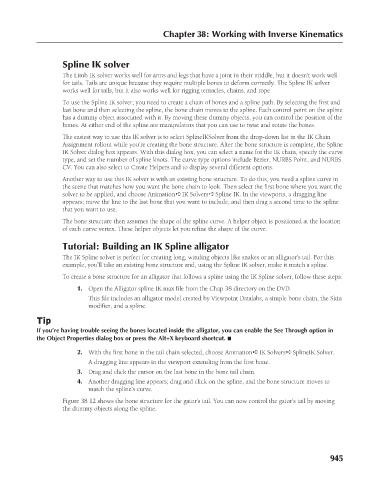Page 993 - Kitab3DsMax
P. 993
Chapter 38: Working with Inverse Kinematics
Spline IK solver
The Limb IK solver works well for arms and legs that have a joint in their middle, but it doesn’t work well
for tails. Tails are unique because they require multiple bones to deform correctly. The Spline IK solver
works well for tails, but it also works well for rigging tentacles, chains, and rope.
To use the Spline IK solver, you need to create a chain of bones and a spline path. By selecting the first and
last bone and then selecting the spline, the bone chain moves to the spline. Each control point on the spline
has a dummy object associated with it. By moving these dummy objects, you can control the position of the
bones. At either end of the spline are manipulators that you can use to twist and rotate the bones.
The easiest way to use this IK solver is to select SplineIKSolver from the drop-down list in the IK Chain
Assignment rollout while you’re creating the bone structure. After the bone structure is complete, the Spline
IK Solver dialog box appears. With this dialog box, you can select a name for the IK chain, specify the curve
type, and set the number of spline knots. The curve type options include Bézier, NURBS Point, and NURBS
CV. You can also select to Create Helpers and to display several different options.
Another way to use this IK solver is with an existing bone structure. To do this, you need a spline curve in
the scene that matches how you want the bone chain to look. Then select the first bone where you want the
solver to be applied, and choose Animation ➪ IK Solvers ➪ Spline IK. In the viewports, a dragging line
appears; move the line to the last bone that you want to include, and then drag a second time to the spline
that you want to use.
The bone structure then assumes the shape of the spline curve. A helper object is positioned at the location
of each curve vertex. These helper objects let you refine the shape of the curve.
Tutorial: Building an IK Spline alligator
The IK Spline solver is perfect for creating long, winding objects like snakes or an alligator’s tail. For this
example, you’ll take an existing bone structure and, using the Spline IK solver, make it match a spline.
To create a bone structure for an alligator that follows a spline using the IK Spline solver, follow these steps:
1. Open the Alligator spline IK.max file from the Chap 38 directory on the DVD.
This file includes an alligator model created by Viewpoint Datalabs, a simple bone chain, the Skin
modifier, and a spline.
Tip
If you’re having trouble seeing the bones located inside the alligator, you can enable the See Through option in
the Object Properties dialog box or press the Alt+X keyboard shortcut. n
2. With the first bone in the tail chain selected, choose Animation ➪ IK Solvers ➪ SplineIK Solver.
A dragging line appears in the viewport extending from the first bone.
3. Drag and click the cursor on the last bone in the bone tail chain.
4. Another dragging line appears; drag and click on the spline, and the bone structure moves to
match the spline’s curve.
Figure 38.12 shows the bone structure for the gator’s tail. You can now control the gator’s tail by moving
the dummy objects along the spline.
945

